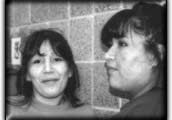
Story by Janice Command
Photos by Rebecca Dallinger

[Reprinted by permission of The Circle.]
Minnesota Correctional Facility-Shakopee surprises a lot a people. Nestled quietly among residential ramblers in the pastoral suburb just southwest of Minneapolis, it has the brick facade and the fenceless grounds of an affluent high school with multiple buildings and a landscaped campus. But MCF-Shakopee is a prison, the only one for women in Minnesota. In spite of the controversies that prisons can generate, there have been no major protests to shut it down during it's 77-year history, not even when the old prison was torn down and this new one was constructed 11 years ago.
|
"Historically, the prison and the community sort of learned to live together," says Connie Roehrich, who has been the facility's warden for five years. "There was never any talk of a fence or a wall. This community has been very accepting of the institution. I think we're good neighbors."
Being a good neighbor means avoiding the concrete-jungle image of men's facilities. There are no bars. There hasn't been an attempted escape in years. And there has never been an in-prison homicide.
"Women respond to incarceration differently than men," explains Roehrich, who presides over a population of only 265 inmates. The small population makes intimate knowledge of individual prisoners and population surveillance easier than in the facilities that warehouse the men. All levels of security inmates are housed in different wings at Shakopee, but the overall atmosphere is more relaxed.
"People call me by my first name," says Roehrich, who notes that the practice is extended to all staff and inmates. "It's pretty informal."
Informal or not, it's still not home to the 20 (by official count) Native women who live there.

Tracy Dahlstom |
"You're here. You can't get out and about like you would out there," says Tracy Dahlstrom, a Prairie Island Dakota. An older woman, she answers questions quietly and literally. "You're with these women with all different kinds of crimes. You got to live with them. You can't pick and choose...and I'm used to being alone. I like being alone. I'd rather stay out in the country." Dahlstrom refuses to talk about the circumstances of her conviction, which was for first-degree manslaughter. She received a seven-year sentence and will do two-thirds of that under the Supervised Release Date (SRD) formula that applies to most prisoners. To keep her spirits up, she participates in the several culturally-focused groups for Native prisoners.
Shakopee allows cultural groups for inmates of color, but fears of gang- formation restrict any truly autonomous groups. Even a craft circle stands to get squelched without an approved overseer. Besides gangs, there are fears of dominant individuals rising to extort fellow prisoners.
"Control is about protecting inmates," says Roehrich. She lists as a top priority "making sure that 265 women are safe in this facility by monitoring people, groups, and behavior. We keep a good handle on people not getting hurt."
In spite of strict regulation, the Indian women in Shakopee are able to meet with the help of community people and agencies who provide spiritual, cultural, and educational opportunities. These groups' efforts include a sweat lodge (conducted by Al Running), a healthy lifestyles group offered by the Minnesota American Indian AIDS Task Force, and a support group convened by the Grandmothers' Society.
The Grandmothers use a traditional spiritual approach in their work with the inmates.
"We try to help them to understand things about the culture," says Sandra Turpin, a Grandmother volunteer. "The culture group is a time to set aside for ceremony and prayer, to bring women to a different spot inside themselves."
It is a precious outlet for many Indian women prisoners, especially in light of the tobacco and burning bans recently launched in all the prisons. Such observance is now restricted to the approved meetings and the chaplain's resource room, with permission.
"When I first got here we used to be able to burn sage every morning," says Carol Allen, who entered Shakopee in 1990. "I had my little altar right up on my window with the red cloth, my eagle feather, my sweetgrass, my sage...I would smudge off every morning," she reminisces.
Allen is a long-term inmate. Her sentence, at 15 years, is five times the prison's three-year average. Besides the tobacco ban, Allen has seen other changes. There were fewer than 100 women when she entered Shakopee, a day she remembers well. "It's a really devastating feeling to know that you get everything completely stripped from you," said Allen, who had special worries about the four young children she left on the outside. "I thought I would never see them again."
A White Earth Ojibwe and former registered nurse, Allen maintains her innocence.
"I never even had a traffic ticket," she said, reviewing her criminal history.
"Mine was a political case."

(L to R) Michelle Burnette and Michelle Crow Ghost |
Once inside, she became a lead worker in the prison industries, joined the Odyssey Group for long-term prisoners, and worked hard to meet the exacting requirements to gain more access to her children. She now lives in the Roosevelt Unit, a Shakopee program that allows overnight visits for the younger children of inmates. Allen, with other mothers of teens, successfully petitioned the prison to institute an innovative program to grant overnight visits to teenagers as well.
Close to three-fourths of all the inmates at Shakopee are mothers.
"When women come in the very initial feeling is guilt," says Diane Hagen, Shakopee's Parent and Family Program coordinator. "Perhaps the children know where they are. I encourage them to tell them. It helps the children to cope with their being away."
Many states place little or no priority on addressing the needs of prison mothers. Hagen thinks this is a mistake.
"Mothers make mistakes, but why should we punish the children?" she asks. "Most women get out of prison. Children need as good a parent as they possibly can have.
"They can reestablish the bond while they're here," Hagen continues. "And for the ones who have had a healthy bond all along, it's a life-saver. We've had some people who have done a terrific job of parenting while in prison." There is a playground on the campus and the Roosevelt Unit is decorated with children's art. There are bunks in a couple of special rooms for family visits. You can see them through glass in the walls. The common area is wide open to allow constant observation while mothers and kids bake, watch videos, and read books. The women are glad for the space.
"We just spend quality time together," said Allen, who cooks frybread, cookies, and Rice Krispie bars when the kids come over on assigned days. "We touch. They crave that."
Sarah Mills calls her children on the phone. Their guardians don't have cars, so visits with them are few. She says her children are her biggest worry, but the possible length of her sentence weighs her down. With outstanding charges looming and a move to have her convicted as a career criminal, she may be looking at another five years. Mills doesn't deny her guilt.
"I think I need to be here, but I don't think five years," she says.
Her convictions have been for those crimes most associated with women: property violations. An addict, she ran forgery and credit card scams to stay supplied.
"If I stay away from certain people, then I'm okay," she says, but she admits to caving in to peer pressure after treatment. "I consider them my family. I've been around them since I was 18. It's hard to break those ties." Mills, a Mille Lacs enrollee, is 27, but looks like a young community college student. An adoptee, she associated with Native people for the first time during her last stint in Shakopee in 1995. Identity issues, buried deep, surfaced during treatment and figured into her pattern of usage.

Sara Mills |
Michelle Burnette will complete her eight-month sentence for possession of crack cocaine this month. It's her first adult conviction, although she has abused illegal substances for a long time.
"They kept sending me to treatment, and I kept leaving because I wanted to be in a Native American treatment center," she says.
Burnette is adamant about wanting to go to a Native-specific narcotics treatment center, although she knows of none that meet that requirement. Still, she says rehabilitation is a concept she believes in.
"It's up to you," says Burnette, who has assembled fishing lures at 40-cents-an- hour as part of the prison industries program. Minimum wage doesn't apply in prison. Small raises and better jobs-including outside work-come with length of stay and work record, but Burnette's stint is short. She will probably not get much more than that. She wants to work when she gets out. She says she has also benefitted from the culture group approach to self-reflection.
"The groups help me to understand myself and why I chose to do the things that I did to get in here in the first place," she says. "It makes me feel proud again because when I was smoking crack I turned to the streets."
Burnette says she started to use crack to deal with personal abuse issues and loneliness. After awhile it became a way to forget the daily downward spiral caused by the addiction itself, that included homelessness and prostitution. She has scars on her hand from warding off a knife attack and once fought her way out of an attempted abduction.
Asked if she wants these details in print, she replied: "I don't mind. I haven't read anything about it in The Circle, but I think it should be talked about. I get the picture that a lot of the Indian women don't even deal with the Indian women who are out there in prostitution. They just kind of badmouth them."
Burnette is another woman who seems younger than her years. Sometimes she gets shy, like an adolescent, and you can barely hear her talk. It's like watching a candle going out. Then she brightens at remembering one success: "Years ago, before crack, I was into powder for a long time. I quit. Got in school. Got a job. I did that on my own because I wanted to."
Alice Red Elk, of the Grandmothers Society, has gone into prisons for years. Whether men or women, she says her approach to inmates is the same.
"We don't know when someone's getting out or why they're in," she says. "We're there to provide culture and spirituality. We're not there to judge."
Red Elk says that interactions with Shakopee's administration have been positive. "We've always gotten what we've asked for, and it's always for the women."
Exactly how many Native women are in Shakopee prison is a minor debate. Some say that the numbers of mixed-race and non-enrolled women may equal the official count. One thing is certain: More Native women will wind up there as the overall women's prison population grows, due in large part to stronger sentencing and review guidelines. Warden Roehrich says that plans are underway to request appropriations for an additional building to accommodate what has already become an overflow situation.
Author's note: When asked for ways the community could support the inmates, Michelle CrowGhost, the cultural group's current feather-keeper, said the women could use craft materials, like beads. The women use them to make give-away items at the two pow wows they host each year. If you would like to make a donation, call the Grandmother's Society (612)-721-1089.
This site is maintained by JS Dill.